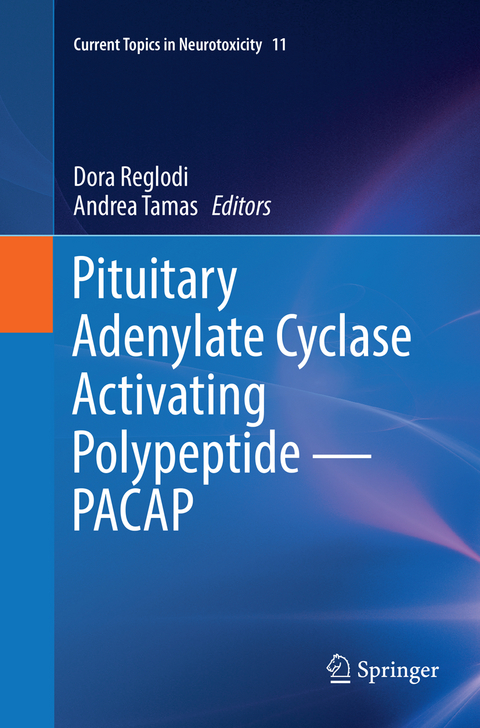
Pituitary Adenylate Cyclase Activating Polypeptide — PACAP
Springer International Publishing (Verlag)
978-3-319-81732-3 (ISBN)
Dora Reglodi, MD, PhD, DSc, is a full professor and chair in the Department of Anatomy at the University of Pécs Medical School, Hungary. Andrea Tamas, MD, PhD, is an associate professor in the Department of Anatomy at the University of Pécs Medical School, Hungary.
Part 1. Evolutionary Aspects of PACAP.- 1. Molecular evolution of Pituitary adenylyl cyclase-activating polypeptide subfamily and cognate receptor subfamily.- 2. Occurrence, distribution and physiological function of pituitary adenylyl cyclase-activating polypeptide in invertebrates species.- 3. PACAP-like compounds of earthworms: identification and putative functions from embryonic development to brain regeneration.- 4. PACAP and learning in invertebrates.- Part 2. Effects of PACAP in Neuronal Development.- 5. PACAP and Neural Progenitor cells.- 6. PACAP and neural development.- 7. PACAP modulates distinct neuronal components to induce cell-specific plasticity at central and autonomic synapses.- Part 3. PACAP Receptors and Signalling.- 8. The pharmacophoric determinants of PACAP.- 9. PACAP-derived carriers: mechanisms and applications.- 10. Effects and development of TAT-tagged PACAP/VIP and related peptides.- Part 4. Presence and Physiological Functions of PACAP in Diverse Systems.-11. Presence and role of PACAP in endocrine glands of mammals.- 12.Distribution of PACAP in the mammalian nervous system.- 13. Multiple mechanisms contribute to the PAC1 modulation of parasympathetic cardiac neuron excitability.- 14. PACAP in the circadian timing system - learning from knockout models.- 15. The role of PACAP in the regulation of body temperature.- Part 5. Presence and Functions of PACAP in the Gastrointestinal and Urinary Tracts.- 16. PACAP Regulation of gastrointestinal function and obesity.- 17. Protective intestinal effects of pituitary adenylate cyclase activating polypeptide.- 18. Renoprotective effects of pituitary adenylate cyclase-activating polypeptide 38 (PACAP38).- 19. Neuroplasticity of PACAP expression and function in micturition reflex pathways.- Part 6. Functions of PACAP in the Skeletal System.- 20. Role of PACAP and VIP signalling inregulation of chondrogenesis and osteogenesis.- 21. Role of PACAP/VIP in bone and joint physiology and pathophysiology.-Part 7. PACAP in the Regulation of the Reproductive System.- 22. Role of PACAP and its PACAP type I receptor in the central control of reproductive hormones.- 23. Occurrence and functions of PACAP in the placenta.- 24. PACAP in the reproductive system.- Part 8. PACAP in Biological Barriers and Barrier-Forming Cells.- 25. Transport of Pituitary Adenylate Cyclase Activating Polypeptide across the Blood-brain Barrier: Consequences for Disease States and Therapeutic Effects.- 26. Effects of PACAP on biological barriers.- 27. Role of PACAP in astrocytes and astrocytic tumors.- 28. Multiple actions of pituitary adenylate cyclase-activating polypeptide (PACAP) in Schwann cell biology.- Part 9. PACAP in Sensory Systems.- 29. Sniffing Out a Role for PACAP in the Olfactory System.- 30. Retinoprotective effects of PACAP.- 31. Pituitary adenylate cyclase activating polypeptide in the auditory system.- Part 10. Neuroprotective effects of PACAP.- 32. PACAP signaling in neuroprotection.- 33. PACAP expression and plasticity in the peripheral nervous system.- 34. The neuropeptide PACAP, a potent disease modifier candidate for brain stroke treatment.- Part 11. PACAP in the Pathomechanism of Migraine and Pain.- 35. Pituitary adenylate cyclase activating polypeptide (PACAP) in migraine pathophysiology.- 36. PACAP regulation of vascular tone: differential mechanism among vascular beds.- 37. PACAP circuits mediating the sensory and behavioral consequences of pain.- Part 12. Role of PACAP in Inflammatory Processes.- 38. PACAP modulation of CNS and peripheral inflammation.- 39. PACAP regulation of inflammatory and free radical networks in neuronal and non-neuronal diseases.- 40. Immunobiology of the pituitary adenylate cyclase-activating peptide.- Part 13. PACAP in Stress and Mood Disorders.- 41. PACAPergic synaptic signaling and circuitry mediating mammalian responses to psychogenic and systemic stressors.- 42. Using PACAP heterozygous mice as models of the three hit theory of depression.- 43. PACAP and Depression.- 44. Implications of PACAP signaling in psychiatric disorders.- 45. Mechanisms of PACAP in PTSD and stress-related disorders in humans.- 46. PACAP, VIP and ADNP: autism and schizophrenia.- Part 14. Clinical Relations of PACAP.- 47. PACAP and cancer.- 48. PACAP as a potential biomarker - alterations of PACAP levels in human physiological and pathological conditions.- 49. Examination of PACAP during lactation.- Index.
| Erscheinungsdatum | 05.03.2022 |
|---|---|
| Reihe/Serie | Current Topics in Neurotoxicity |
| Zusatzinfo | XIII, 840 p. 114 illus., 64 illus. in color. |
| Verlagsort | Cham |
| Sprache | englisch |
| Maße | 155 x 235 mm |
| Gewicht | 12686 g |
| Themenwelt | Medizin / Pharmazie ► Studium |
| Naturwissenschaften ► Biologie ► Humanbiologie | |
| Schlagworte | Neuropeptide • Neuroprotection • PAC1 receptor • PACAP • VIP |
| ISBN-10 | 3-319-81732-9 / 3319817329 |
| ISBN-13 | 978-3-319-81732-3 / 9783319817323 |
| Zustand | Neuware |
| Haben Sie eine Frage zum Produkt? |
aus dem Bereich


